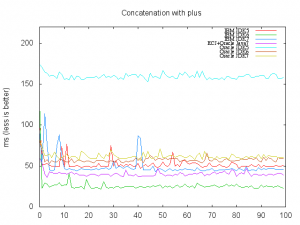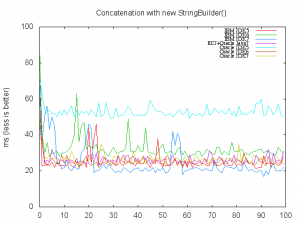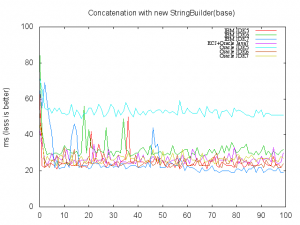Java StringBuilder myth debunked
The myth
Concatenating two Strings with the plus operator is the source of all evil
— Anonymous Java dev
NOTE: The source code for the tests discussed here can be found on Github
It’s from university time that I learned to regard String concatenation in Java using the ‘+’ plus operator as a deadly performance sin. Recently there has been an internal review at Backbase R&D where such recurring mantra was dismissed as a myth due to javac using StringBuilder under the hood any time you use the plus operator to join Strings. I set myself up to prove such a point and verify the reality under different environments.
The test
Relying on your compiler to optimize your String concatenation means that things might change heavily depending on the JDK vendor you adopt. As far as platform support goes for my daily job, three main vendors should be considered:
- Oracle JDK
- IBM JDK
- ECJ — for developers only
Moreover, while we officially support Java 5 through 6, we are also looking into supporting Java 7 for our products, adding another three-folded level of indirection on top of the three vendors. For the sake of lazyness simplicity, the ecj compiled bytecode will be run with a single JDK, namely Oracle JDK7. I prepared a Virtualbox VM with all the above JDK installed, then I developed some classes to express three different concatenation methods, amounting to three to four concatenations per method invocaiton, depending on the specific test case. The test classes are run a thousands times for each test round, with a total of 100 rounds each test case. The same VM is used to run all the rounds for the same test case, and it’s restarted across different test cases, all to let the Java runtime perform all the optimizations it can, without affecting the other test cases in any way. The default options were used to start all JVMs. More details can be found in the benchmark runner script.
The code
Full code for both test cases and the test suite is available on Github. The following different test cases were produced to measure performance differences of the String concatenation with plus against the direct use of a StringBuilder:
// String concat with plus String result = 'const1' + base; result = result + 'const2';
// String concat with a StringBuilder
new StringBuilder()
.append('const1')
.append(base)
.append('const2')
.append(append)
.toString();
}//String concat with an initialized StringBuilder
new StringBuilder('const1')
.append(base)
.append('const2')
.append(append)
.toString();The general idea is to provide a concatenation both at the head and at the tail of constant Strings over a variable. The difference between the last two cases, both making explicit use of StringBuilder, is in the latter using the 1-arg constructor which initializes the builder with the initial part of the result.
The results
Enough talking, down below here you can have a look at the generated graphs, where each data point corresponds to a single test round (e.g. 1000 executions of the same test class). The discussion of the results and some more juicy details will follow.
The discussion
Oracle JKD5 is the clear loser here, appearing to be in a B league when compared to the others. But that’s not really the scope of this exercise, and thus we’ll gloss over it for the time being. That said, there are two other interesting bits I observe in the above graph. The first is that indeed there is generally quite a difference between the use of the plus operator vs an explicit StringBuilder, especially if you’re using Oracle Java5 which performs tree times worse the the rest of the crew.
The second observation is that while it generally holds for most of the JDKs that an explicit StringBuilder will offer up to twice the speed as the regular plus operator, IBM JDK6 seems not to suffer from any performance loss, always averaging 25ms to complete the task in all test cases. A closer look at the generated bytecode reveals some interesting details
The bytecode
NOTE: the decompiled classes are also available on Github Across all possible JDKs StringBuilders are always used to implement String concatenation even in presence of a plus sign. Moreover, across all vendors and versions, there is almost no difference at all for the same test case. The only one that stands a bit apart is ecj, which is the only one to cleverly optimize the CatPlus test case to invoke the 1-arg constructor of the StringBuilder instead of the 0-arg version.
Comparing the resulting bytecode exposes what could affect performance in the different scnarios:
- when concatenating with plus, new instances of
StringBuilderare created any time a concatenation happens. This can easily result in a performance degradation due to useless invocation of the constructor plus more stress on the garbage collector due to throw away instances - compilers will take you literally and only initalize
StringBuilderwith its 1-arg constructor if and only if you write it that way in the original code. This results in respectively four and three invocations ofStringBuilder.appendfor CatSB and CatSB2.
The conclusion
Bytecode analysis offers the final answer to the original question. Do you need to explicitly use a StringBuilder to improve performance? Yes The above graphs clearly show that, unless you’re using IBM JDK6 runtime, you will loss 50% performance when using the plus operator, although it’s the one to perform slightly worse across the candidates when expliciting StringBuilders. Also, it’s quite interesting to see how JIT optimizations impact the overall performance: for instance, even in presence of different bytecode between the two explicit StringBuilder test cases, the end result is absolutely the same in the long run.

Reference: Java StringBuilder myth debunked from our JCG partner Carlo Sciolla at the Skuro blog.






Why is the title “Java StringBuilder myth debunked”? Didn’t you confirm that the myth is actually true?
From the “String concat is source of all evil” doctrine, one would expect it to be much worse. Also, as stated in the article, starting from Java 6, there is no difference in results.
>> Concatenating two Strings
May be you should test someone, like this?
String a = c1.getString();
String b = c2.getString();
String c = a + b;
I have a feeling that your unnecessarily splitting a concatenation that can and should be done in a single statement into 3 separate statements has a significant effect on your results here. String result = “const1” + base; result = result + “const2”; return result + append; should just be return “const1” + base + “const2” + append; It’s not surprising that the compiler doesn’t optimize perfectly when given code like that. (As an aside, don’t use System.currentTimeMillis() for measuring elapsed time… only System.nanoTime() can be relied on for that. System.currentTimeMillis() is provides wall clock time, which can be adjusted… Read more »
…also I find the more common case has multiple string +’es:
res = “File: “+filename+” was open for “+n+” sec. but less than “+nw+” records were written”;
Perhaps that would make the difference less dramatic?
That’s true for logging, which IMHO isn’t the majority of String concat cases
i’m not sure that I consider this much of a revelation. Your test code using the ‘+’ operator will generate three StringBuilders instead of one. The Java compiler has no optimization where it will determine, across expressions, that its safe to reuse the same StringBuilder instance. These results don’t surprise me at all, and I think may lead people to the wrong conclusions about when it is and is not appropriate to use StringBuilder versus the string append operator. If you look at an example like this: public String getSomeString() { return foo + “:” + bar; } and then:… Read more »
Good for you that you knew all the details, I’m no expert on compiler optimizations, and for me it’s not obvious what could be faster and what not.
As an example, ecj shows that something can be improved here and there over the basic approach of always creating fresh StringBuilders on demand. Moreover, I would have expected JIT optimizations to kick in with a somewhat visible impact, and it was a surprise for me not to see any.
The JIT optimizations *do* kick in. But there is not HotSpot operation to coalesce StringBuilders. The dataflow analysis to determine if it was truly safe to do would be prohibitively expensive.
@twitter-14392123:disqus the first writing of the post was a follow up to an internal discussion where the claim to debunk was that compilers are clever enough to optimize string concatenations, relieving programmers from manually create and manage StringBuilders. Re-reading it in its final version I agree that the title could have been adjusted.
The real performance killer of the + operator is when it is used inside loops. For each iteration of the loop, new StringBuilder instances are created, and turned into String instances using .toString(). Every time a StringBuilder is created from the String being built, all the characters must be copied into the StringBuilder to keep the original String immutable. And, when the StringBuilder is turned into a String again, all the characters are again copied from the StringBuilder into the String, again to make sure that the new String is immutable. As the String grows, the same characters are copied… Read more »
Good explanation. All the time I think about this situation. But I usually like to use str.concat()! But I never had a time to compare wich one is better.
I like how you titled this “myth debunked” and confirmed it.
Really helpful! Not confusing at all! Durp
THIS TEST IS A COMPLETE LIE!!!
The problem is that
String result = ‘const1’ + base;
result = result + ‘const2’;
translates to
String result = new StringBuilder(‘const1’).append(base).toString();
result = new StringBuilder(result).append(‘const2’);
This means TWO conctructions and TWO toString() calls. No wonder the example takes more time in the benchmark!
BUT: If you use
String result = ‘const1’ + base + ‘const2′;
it will become
String result = new StringBuilder(”const1’).append(base).append(‘const2’).toString();
AND THAT WILL BE AS QUICK AS THE OTHERS!
I always give the constructor a reasonable size initial size. One that will hopefully contain the size of the finished ‘string’, and at least limit the number of times the internal buffer as to be ‘resized / copied’.
StringBuilder sb = new StringBuilder(256).append(“xxxx”)……..